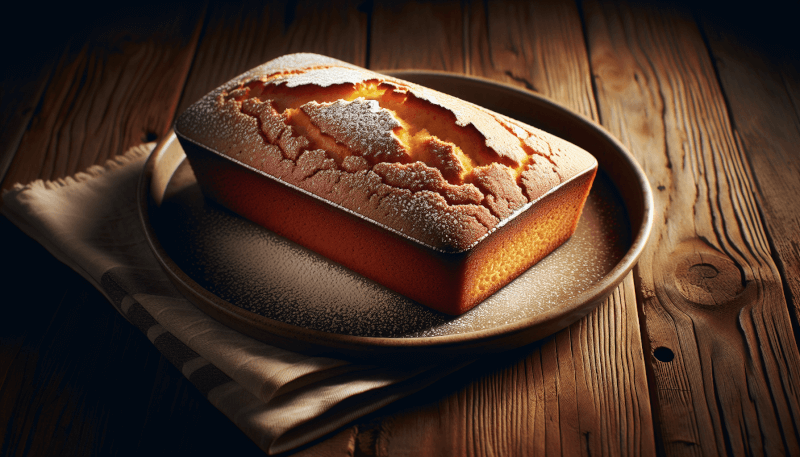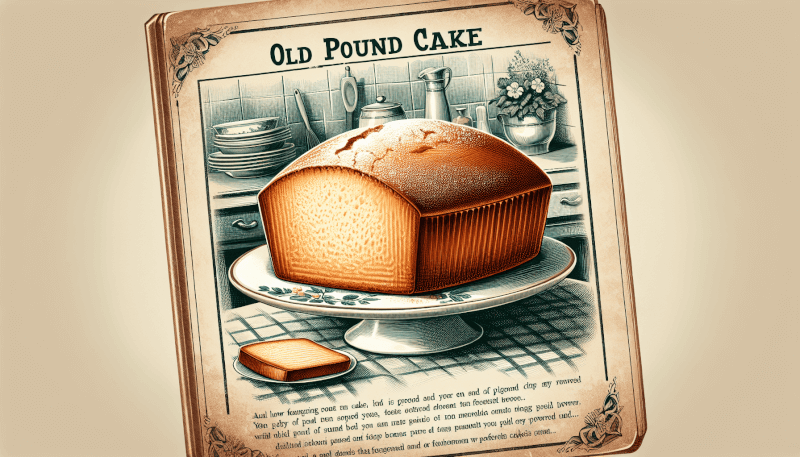Want to indulge in a classic dessert that brings nostalgia and comfort with every bite? Look no further than this timeless Old Fashioned Pound Cake Recipe. With its rich and buttery flavors, dense yet tender texture, and a hint of vanilla, this cake is sure to transport you to simpler times. Whether you’re a baking enthusiast or just looking to satisfy your sweet tooth, this recipe is a must-try. Follow these simple steps and get ready to enjoy the perfect slice of nostalgia.
Ingredients
To make a delightful old-fashioned pound cake, you will need the following ingredients:
All-purpose flour
A staple in every baker’s pantry, all-purpose flour provides the structure and foundation for the pound cake.
Granulated sugar
Sweetness is an essential component of any pound cake, and granulated sugar adds just the right amount of sweetness to this classic recipe.
Unsalted butter
Butter is the star ingredient in a pound cake, providing rich flavor and a tender crumb. Make sure to use unsalted butter for better control over the salt content.
Eggs
Eggs are what give pound cake its dense and moist texture. They also contribute to the cake’s richness, making it a true indulgence.
Vanilla extract
The addition of vanilla extract adds a touch of warmth and enhances the overall flavor of the pound cake. Use pure vanilla extract for the best results.
Salt
While salt may seem like a small ingredient, it plays a crucial role in balancing the flavors of the pound cake. Just a pinch is enough to elevate the taste.
Buttermilk
Buttermilk, with its tangy and creamy properties, adds moisture and tenderness to the pound cake. It also helps in achieving a light and fluffy texture.
Preparation
Follow these steps to prepare your old-fashioned pound cake:
Preheat the oven
Before you start mixing the ingredients, preheat your oven to the correct temperature. For pound cakes, a temperature of 325°F (165°C) is typically recommended.
Grease the pan
To ensure your pound cake doesn’t stick to the pan, generously grease it with butter or cooking spray. This allows for easy removal once the cake is baked.
Cream the butter and sugar
In a mixing bowl, cream together the unsalted butter and granulated sugar until light and fluffy. This process incorporates air into the mixture, creating a tender texture in the cake.
Add the eggs
One by one, add the eggs to the butter and sugar mixture, beating well after each addition. This step ensures that the eggs are thoroughly mixed and contributes to the moistness of the pound cake.
Mix in the vanilla extract
Blend in the vanilla extract, which adds a delightful aroma and flavor to the pound cake. Stir until the extract is fully incorporated.
Combine the dry ingredients
In a separate bowl, whisk together the all-purpose flour and salt. This step ensures an even distribution of the salt throughout the cake and helps to avoid clumps of flour.
Alternate adding the dry ingredients and buttermilk
Gradually add the dry ingredients and buttermilk to the butter mixture, starting and ending with the dry ingredients. This technique allows for thorough mixing and prevents the batter from curdling.
Pour the batter into the pan
Carefully pour the cake batter into the greased pan, ensuring it is evenly spread. Use a spatula to smooth the top for a uniform appearance.
Bake the cake
Place the pan in the preheated oven and bake for about 60 to 70 minutes, or until a toothpick inserted into the center comes out clean. The cooking time may vary, so keep an eye on the cake as it bakes.
Cool and remove from the pan
Once the cake is baked, allow it to cool in the pan for about 10 minutes. Then, gently run a knife along the edges of the cake to loosen it, and carefully remove it from the pan to cool completely on a wire rack.

Variations
While the classic pound cake is undeniably delicious, you can also experiment with different flavors and variations to add a unique twist to your recipe. Here are a few popular variations:
Lemon pound cake
Add some zest and tanginess to your pound cake by incorporating freshly squeezed lemon juice and grated lemon zest. The bright citrus flavors will transform the traditional pound cake into a refreshing dessert.
Almond pound cake
For a delightful nutty flavor, add almond extract or ground almonds to the batter. You can also top the cake with sliced almonds for an extra crunch.
Chocolate marble pound cake
To satisfy your chocolate cravings, create a marbled effect by swirling in a mixture of cocoa powder and melted chocolate. This variation is a visual treat and a chocolate lover’s dream.
Orange pound cake
Infuse your pound cake with the refreshing taste of oranges by adding orange zest or freshly squeezed orange juice. The citrusy aroma and flavor will make your taste buds sing.
Serving Suggestions
Now that you have baked your mouthwatering old-fashioned pound cake, it’s time to think about how to serve it and enhance its flavors even further. Here are some serving suggestions:
Dust with powdered sugar
Give your pound cake an elegant finishing touch by dusting it with powdered sugar. This adds a touch of sweetness and a beautiful snowy appearance.
Serve with whipped cream
A dollop of freshly whipped cream pairs perfectly with a slice of pound cake. The lightness of the cream complements the rich and dense texture of the cake, creating a blissful combination.
Top with fresh berries
Take advantage of seasonal fruits and top your pound cake with vibrant fresh berries, such as strawberries, raspberries, or blueberries. The fruity burst adds a refreshing and colorful element to your dessert.
Drizzle with chocolate ganache
For the ultimate indulgence, pour a luscious and glossy chocolate ganache over the pound cake. The smooth and velvety chocolate enhances the luxuriousness of the cake.

Tips and Tricks
To ensure your old-fashioned pound cake turns out perfectly every time, here are some tips and tricks to keep in mind:
Bring ingredients to room temperature
Before you start baking, make sure the butter, eggs, and buttermilk are all at room temperature. This helps in achieving better incorporation of ingredients and results in a smoother batter.
Cream butter and sugar thoroughly
Take your time while creaming the butter and sugar, ensuring the mixture becomes light and fluffy. This step is integral to creating a tender texture in your pound cake.
Sift the dry ingredients
To remove any lumps or impurities from the flour, sift it before mixing it with the other ingredients. This process creates a lighter and more uniform batter.
Bake at the right temperature
Maintaining the recommended temperature while baking is crucial for even cooking. Check your oven’s temperature using an oven thermometer, as oven settings can vary.
Use a toothpick to test for doneness
To determine if your pound cake is fully baked, insert a toothpick into the center. If it comes out clean or with a few moist crumbs, the cake is ready. If there is wet batter clinging to the toothpick, it needs more baking time.
Storage
If you find yourself with leftover pound cake or want to prepare it in advance, here are some storage options:
Store in an airtight container
To keep your pound cake fresh, store it in an airtight container at room temperature. This will maintain its texture and prevent it from drying out.
Refrigerate for longer shelf life
If you want to extend the shelf life of your pound cake, place it in the refrigerator. The chilled environment will help it stay moist for a longer period.
Freeze for future enjoyment
Pound cake freezes exceptionally well. Wrap it tightly in plastic wrap, followed by aluminum foil or a freezer-safe container. It can be stored in the freezer for up to three months. Thaw it in the refrigerator overnight before serving.
Troubleshooting
Even the most seasoned bakers encounter challenges. Here are some common issues you may face while making a pound cake and how to overcome them:
Cake is too dry
If your pound cake turns out dry, it may be due to overbaking. Check the cake a few minutes earlier than the recommended baking time to prevent it from drying out.
Cake is too dense
Dense pound cakes can result from not creaming the butter and sugar adequately. Ensure that you follow the creaming step thoroughly, allowing enough time for the butter and sugar to become light and fluffy.
Cake is sinking in the middle
Several factors can cause a cake to sink in the middle, such as opening the oven door too soon or not incorporating the ingredients properly. Avoid opening the oven door until the cake is almost fully baked, and be sure to follow the recipe instructions precisely.
Cake is sticking to the pan
To avoid your pound cake sticking to the pan, ensure it is generously greased before pouring in the batter. You can also line the bottom of the pan with parchment paper for easier removal.
History of Pound Cake
Pound cake has a long and fascinating history, tracing back centuries. Here’s a brief overview of its origins and evolution:
Origin of pound cake
Pound cake originated in Europe in the early 18th century, specifically in England. The name “pound cake” refers to its original recipe, which consisted of one pound each of flour, butter, sugar, and eggs. These simple proportions made it easy to remember and reproduce.
Evolution of pound cake recipe
As pound cake migrated to different countries and cultures, variations in the recipe began to emerge. Ingredients like vanilla and lemon zest were introduced to enhance the flavor. Some regions started using baking powder or baking soda to lighten the cake’s dense texture.
Popularity through the centuries
Pound cake gained immense popularity in the United States during the 18th and 19th centuries. It became a symbol of celebration, often served on special occasions like weddings and holidays. Pound cake quickly became a beloved dessert worldwide, cherished for its simplicity and timeless appeal.
Famous Pound Cake Recipes
Over the years, several renowned chefs and bakers have crafted their own exceptional pound cake recipes. Here are a few famous ones you can try:
Martha Stewart’s Perfect Pound Cake
Martha Stewart, the queen of home cooking, has a delightful recipe for pound cake that delivers moistness and flavor in every bite. Her attention to detail and expertise ensure a foolproof result.
James Beard’s Classic Pound Cake
James Beard, a pioneering American chef and cookbook author, has his classic rendition of pound cake. This recipe showcases his penchant for simple yet exquisite flavors.
Julia Child’s Lemon Pound Cake
The iconic Julia Child, known for introducing French cuisine to American households, offers a lemon-infused pound cake recipe. Her mastery of techniques and dedication to quality shine through in this delightful variation.
Conclusion
In conclusion, the old-fashioned pound cake is a timeless dessert that never fails to impress. With its rich and buttery flavor, dense yet tender texture, and endless variations, it is a versatile and delicious treat for any occasion. Whether you follow the classic recipe or put your own twist on it, a pound cake is a delightful indulgence that never goes out of style. So gather your ingredients, preheat that oven, and get ready to enjoy a slice of pure heaven.


